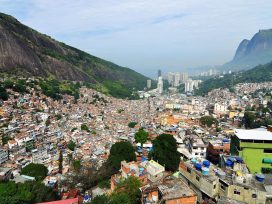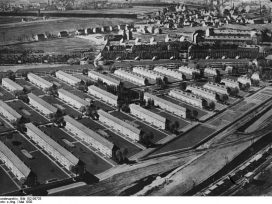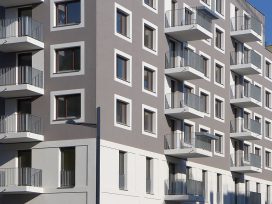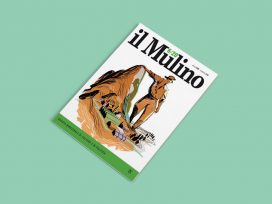1.
I manage to complete my shopping at the market before it closes. Coming out of the market hall, I have to zigzag between pedestrians, shopping carts, bicycles and strollers, all of which are squeezed behind the fences surrounding the construction site for the new Metro. It’s late afternoon and the jackhammers are pounding away again. The dust rises up into the air and spreads over my balcony, table, and clothes hung out to dry. Once more, I think about moving.
I set off to find the bicycle I left somewhere last night. Coming out at the Big Ring, I can follow the tramline for a while, but reaching Blaha Lujza Square I’m forced down into the underpass. I manage to fight my way past beggars, leaflet distributors, signature collectors, the labyrinth of apathetic employees of 24-hour shops and the elegant staff of carefully lit boutiques, to get to the other side. At street level again, I make my way between the cavity of the construction site and the somewhat spontaneous parking lot towards the great socialist department store. The banal metal facade embracing the fin de siècle building contains more than just ordinary shops: it is home to a whole series of canteens and bars, on the ground floor and roof.
Avoiding the lángos and hamburger stalls, I reach the rear entrance where I am bundled into a lift with a couple of strangers and we head upwards. Finally, a narrow set of steps takes us up to the roof. So far there are only a few dozen people sitting around the dilapidated tables. There’s still time to prepare for the evening behind the bar. Above the safety railing that runs around the terrace is an unusual view of the houses of Pest. It is getting dark. With an unlikely sparkle, the lit towers of the New York Palace rise up above the dulled grey of the roofs. On the other side is a bare factory chimney that the floodlight from the terrace turns into a decoration.
2.
The glittering of fin de siècle nostalgia, the aesthetic of ruin of the transforming urban landscape, and the ready-made decorative elements of the terrace all blend the divergent segments of Central European urban memory in a unique fashion. To this day, an imagined notion of adventure and spontaneity covers these recently still infamous parts of central Pest. This notion provides a perfect breeding ground for initiatives that connect dilapidation and an acceptable level of urban impoverishment with an enthusiastic irony regarding the remains of socialism, and make use of all these in the symbolic consumer domain of entertainment. Meanwhile, the giddy heights of a flat roof, as so often rediscovered by feature films, gives the terrace the big city tone into which urban dwellers are from time to time happy to dip. The desire for the unusual, for the architecturally ghostlike, is guaranteed by the reassuring proximity of fin de siècle luxury, on which adventurers arriving from more prestigious districts can turn their backs.
This applies equally to those arriving from more prestigious countries. The Swedish jewellery designer, as he “tries out” the black and white photos he has bought in a second-hand shop against the raw, run-down wall of the house, is happy he is no longer surrounded by that desire for sterility that rid his home city of every little mark. The cracks in the walls, the peeling plaster… the jewels of the city, he says.
3.
It’s true that the marks of war are still present in most Central European cityscapes, often complemented by the superficial symptoms of the change of regime. It’s customary to describe post-socialist urban space as temporary, a fractured space laced with boundaries and thresholds. Even in cities changing more quickly than this “progressing heart”, in the spaces left behind by retreating state planning and now being commercialized, entirely divergent functions and modes of use emerge alongside each other, almost unnoticed, drawing peculiar boundary lines between the spaces of remembrance, progress, informality and control. The ambivalent nature of these boundary lines is nurtured and recorded by the various emblematic locations and sights of the transient urban landscape, like cavity plots performing new simplified functions, mature acacia trees several meters tall in the corner, and firewalls revealed by the bulldozers that offer glimpses of apartment interiors.
Of course, fragmentation is not characteristic of every Central European city. With its compactness, self-examining inwardness, and the quality of its urban spaces and services, Vienna might once have been the prototypical Central European city. But today, the continuity of its architectural fabric stands out as an exception in the region. Nevertheless, Vienna’s logic of avenues and rings helps one to navigate in Prague, Krakow, and Budapest most of all. On the other hand, in Warsaw or Bratislava we need a car or driver if we intend to explore the areas around the old town, not to mention the embodiment of complete fragmentation – Berlin. Yet we can sense the feeling of alienation even when we travel in the opposite direction: travelling from the spacious and green Berlin to the narrow, grey and completely commercialized downtown of Prague can sometimes be a claustrophobic experience.
Berlin’s “twilight landscape” is an immediate breeding-ground for cultural initiatives outside the usual strictures. Activities flirting with the fringe of society find a home in the marginal spaces that voluntarily conserve fragments and remnants outside the city’s neoliberal market structures: that which is run-down, forgotten and unused today appears full of potential in our thought.
The way in which Central European societies and cities are out of step is not an obviously advantageous cultural peculiarity. However, investment capital, which knows western urban development well and is good at acclimatizing to opportunities in the East, moves faster than the cultural sphere. Transforming districts offer multiple possibilities for economic exploitation, even in Berlin: expensive apartments rising up overnight in place of run-down buildings generates an exceptionally rapid gentrification that prevents culture from being a spontaneous force in urban planning.
4.
Capitalizing on fragments and remnants is not only a possibility for cities – it’s an obligation. At odds with one another, the remnants haunt the streets and squares as much as the interiors of houses and apartments. The attitude to relics is not the same everywhere, as indicated in the comments of the Serbian foreign minister Vuk Jeremic about the bombing of Belgrade in 1999: “The reminders are here, and are certainly deeply lodged in people’s memories… but we don’t really need ruins as in Berlin or Hamburg, which were left there on purpose. We don’t need them.”
In fact, it’s not clear who exactly is in need of ruins, of raw architecture lacking illusion. The dilemma facing the new Warsaw Museum of Modern Art helps to identify the East-West divide on wildness versus sterility. Conceived by the Swiss architect Christian Kerez, the building presents itself within Warsaw’s urban fabric, in all its raw concrete glory, in a way that’s not easy on the eye at the best of times. The wildness invoked to balance the revived sterility of western cities melts into its natural habitat in bombed-out Warsaw. Central Europe produced the aesthetic of architectural brutalism in a spontaneous fashion, without having to be asked. The firewalls and cavity plots, ruins of buildings and neglected underpasses, these places full of memories, still pop up here and there, but they increasingly exist like a plague. They remain frozen in transience, right until the day that all faults and telltale signs disappear from the face of the city, and the cities themselves close up into their own sterile presentness.
5.
The disappearance of telltale signs is accompanied by the disappearance of informalities. In Belgrade, less than a decade ago, it was standard practice to leave the train and go immediately to the taxi drivers to get local currency. An adventure-loving friend of mine continued to insist on this informal route, long after the abolition of the embargo on Serbia reopened the country to the world. He simply would not acknowledge the existence of the bank machines and exchange booths springing up all over the city.
On arrival in Bratislava I’m given the following instructions: Look for tram number 20 at the station, take it for half an hour, and get off as soon as I see Tesco on the right hand side of the street. This itinerary made me suspicious, but I gave in. I got off at Tesco, skirted around the group of buildings, continued on an unpaved road, and then reached a fence. I’m looking for the gallery, and I turn in despair to a security guard. Without a word, he points to the little house beyond the fence. I climb over it, bypassing piles of gravel, and, lo and behold, I reach the gallery!
Such situations often don’t work out without being told where to go. My Budapest reflexes also fail me in the centre of Sofia. A friend of a friend rushes to my assistance, and drags me off the beaten path. He leads me to a district full of old, ramshackle houses. We enter a gate, and rush up the stairs to the second floor, then stop in front of a closed door. My host explains that this is a private place of entertainment. There’s a few like it in this area. They only let in people they know or who they like the look of. They know my guide, so we can enter the apartment, spacious rooms filled with Andalusian afternoon music. There are well-dressed young people in comfy armchairs and couches. I sense it is a privilege to be here.
Maps or guidebooks cannot guarantee successful navigation. Central Europe’s cities change so rapidly that only direct everyday experience can keep pace. I’m reminded of the film Warsaw, where a driver arriving in the city in winter cannot find anything where it was. He returns at various points in the film, asking about street names that no longer exist and can’t be recalled.
When I arrive in Warsaw, I can immediately imagine that the city provides the perfect spaces for forgetting. In the 1990s, light green skyscrapers emerged from the blocks of the 1960s that took the place of the historical districts that were razed to the ground during the war. These towers became part of the exclusive utopian space created in the great business districts of western and Far Eastern cities. They carry with them the promise of an optimistic atmosphere, free of problems, doubts and memories, a rare thing in Central Europe. However, this vertical indulgence is offset by the everyday poverty dominating the streets, and by the raw lack of architectural illusion that spreads as far as the eye can see.
6.
Central Europe’s common architectural space exits thanks to the interchangeable elements of the neoclassicist eclectic style of the monarchy, and the way these harmonize with one another. In the culture of duplicates, which linked together otherwise competing cities with common interdependencies and points of reference, each city provides a small-scale copy, mark or synecdoche of the other. The Europe Courtyard in Bratislava is only a parody of this phenomenon, but at one time whole cities bore the title of “Little Vienna” or competed in designating themselves the “Paris of the East”.
If a city is text, then the Central European city is hypertext. Street names and even parts of cities have no choice but to bear the names of other parts of the region – think of the Krakovo district of Ljubljana or the Praga district of Warsaw. It is the Central European mix of languages, words, signs and melodies which crystallizes in urban space, with the theatres scattered over the territory of the Monarchy in the style of the Fellner and Hellmer workshop, or the startling buildings of Joze Plecnik. Perhaps it’s the notion of “radical eclecticism”, which the architect László Rajk used to try to put into words Budapest’s architectural traditions and sources of inspiration, refers to these temporal and spatial wanderings of symbols. An alternative city guide describes Warsaw as an “eclectic cocktail”.
This degree of mutually incestuous cross-referencing creates a sensation of homelessness. Often provoking symptoms of claustrophobia in the art and literature of the region, this homelessness was later ruptured by the completely delegitimized architecture of post-war modernism. The Central European ideology of regime change has been unable to find an architectural partner for itself, with the “socialist city” giving way to urban marketing, which increasingly institutionalizes nostalgic attachment to the peaceful, supposedly multicultural era of the turn of the twentieth century.
The selective memory of Central European cities is not well disposed to the architectural modernism associated with totalitarian regimes, nor to the patterns of contemporary thinking that traces its origins to modernism. Architectural initiatives to connect the environment to opportunities for independent and community innovation seem to slumber between the same parentheses of collective amnesia as certain twentieth century social achievements. The rediscovery of modernism is only taking place within particular professional enclosures and in urban communities that have no other choice in the way they determine their heritage: Berlin and Warsaw. This picture is only made more complicated by the return of socialist housing estates to the agenda, largely thanks to state plans to renovate them.
7.
What, then, is the common heritage of Central European cities? The buoyant serenity of the fin de siècle, which comforts those adverse to the present with fragile promises of continuity? Or the opposite: A continuous transience, in whose endless swirl the temporary status of the post-socialist city can find its natural place. A place from which even Vienna, freed from the awkward proximity of the Iron Curtain, is not excluded?
And what is the meaning of the present for these cities? The sharpening of disagreements, in which the localizability of internal differences makes national conflicts all the more conspicuous in an urban context? Or rediscovered diversity in which the deafening calls of birds in Krakow’s Planty gardens, the echoes of the bells of Gdansk, the thunder of hooves of Vienna’s horse-drawn carriages, the swish of Berlin’s S-Bahn dashing past, the growl of the Vltava dams in Prague, the jingle of the trams in Buda and the strains of a Belgrade brass band all merge into the noise fragments of a single city?
I’d like to believe that Budapest is again closely connected to the other cities of the region, not just by economic strategies, agreements and highways, but also by wandering people, objects and histories. Perhaps it will simply be the new multidirectional mobility, strengthened by open borders, a human and friendly low-rise look, and the rediscovery of hospitality, which will help the cities of Central Europe to become each other’s suburbs and neighbouring districts.






